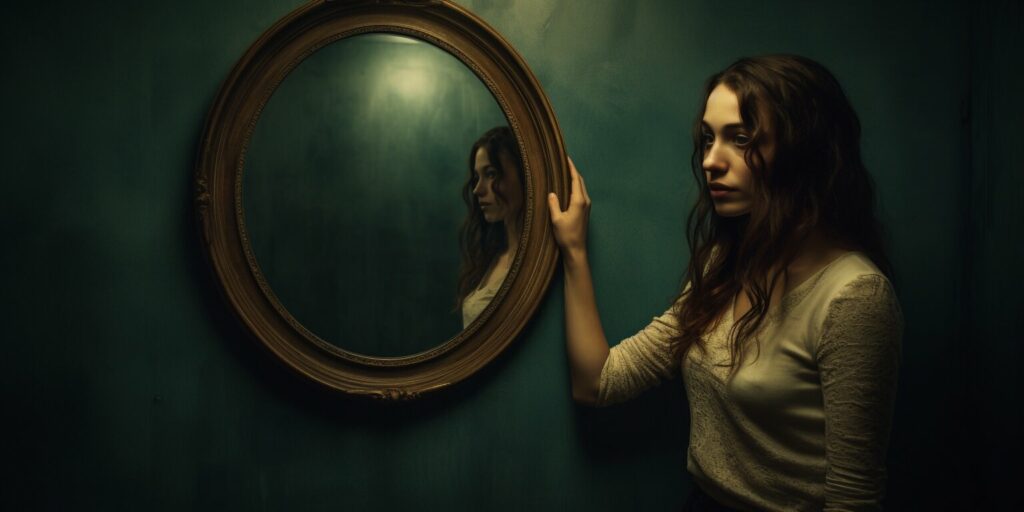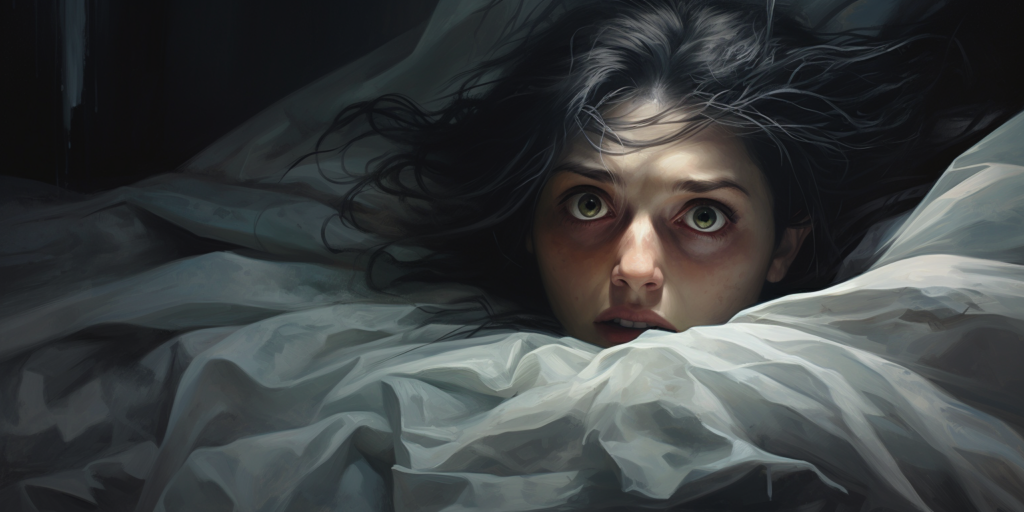Mirror phobia, also known as spectrophobia or eisoptrophobia, is a condition characterized by an intense fear or aversion to mirrors. For those who suffer from this phobia, merely catching a glimpse of their reflection can trigger feelings of anxiety, panic, and even dread. While it may seem irrational to some, mirror phobia is a real and distressing issue that affects individuals across different age groups.
The origins of mirror phobia can vary from person to person. Some individuals develop this fear as a result of traumatic experiences involving mirrors, such as witnessing a loved one’s death in front of a mirror or having a frightening encounter with their own distorted reflection. Others may have inherited the phobia through genetic predisposition or learned it through observing others’ fearful reactions.
Living with mirror phobia can be challenging as mirrors are ubiquitous in our daily lives. Simple tasks like grooming or walking past reflective surfaces can become daunting for those with this condition. Seeking professional help from therapists specializing in anxiety disorders can provide effective strategies for managing and overcoming mirror phobia.
Understanding the causes and symptoms of mirror phobia is crucial in promoting empathy and support for individuals struggling with this condition. By shedding light on this often misunderstood fear, we can work towards creating an environment that fosters understanding and compassion for those affected by mirror phobia.
Understanding Mirror Phobia
Mirror phobia, also known as catoptrophobia, is an intriguing psychological condition that affects individuals in different ways. The fear of mirrors may seem irrational to some, but for those who experience it, the anxiety and distress can be very real. In this section, we’ll delve deeper into understanding mirror phobia and explore some possible explanations for its occurrence.
- Origins of Mirror Phobia
Mirror phobia can stem from various underlying factors. One possible cause is a traumatic event or negative experience associated with mirrors. For example, someone might have witnessed a frightening reflection during a stressful situation or encountered distorted images in funhouse mirrors. These experiences can create lasting emotional imprints and trigger anxieties whenever faced with mirrors later on. - Symbolic Interpretation
Mirrors hold symbolic significance in many cultures and belief systems, which can contribute to the development of mirror phobia. Some people may associate mirrors with supernatural entities, such as ghosts or spirits, leading to a fear of seeing something unnatural or disturbing in their reflections. Additionally, mirrors are often linked to vanity and self-perception, making individuals prone to self-consciousness more susceptible to mirror-related fears. - Body Dysmorphic Disorder (BDD)
Mirror phobia can also be closely tied to body dysmorphic disorder (BDD), a mental health condition characterized by obsessive preoccupation with perceived flaws in one’s appearance. Individuals with BDD may avoid looking at themselves in mirrors due to distorted body image perception and intense feelings of shame or disgust toward their own reflection. - Cognitive Distortion
Another aspect that contributes to mirror phobia is cognitive distortion—the tendency to interpret neutral stimuli negatively. People experiencing this distortion may perceive their reflection as disfigured or menacing even when no objective abnormalities are present. This skewed interpretation reinforces their fear response and intensifies their aversion towards mirrors. - Treatment Options
Fortunately, there are various therapeutic approaches available to help individuals overcome mirror phobia. Cognitive-behavioral therapy (CBT) is often used to challenge and reframe irrational thoughts associated with mirrors, gradually reducing fear and anxiety. Exposure therapy, where gradual exposure to mirrors takes place in a controlled environment, can also be effective in desensitizing individuals to their fears.
Understanding the complex nature of mirror phobia is crucial in providing support and guidance for those affected by this condition. By exploring its origins, symbolic interpretations, potential links with body dysmorphic disorder, cognitive distortions, and treatment options, we can foster empathy and promote a better understanding of this unique phobia.
Causes of Mirror Phobia
Mirror phobia, also known as catoptrophobia, is a specific phobia characterized by intense fear or aversion towards mirrors. While the exact causes of mirror phobia can vary from person to person, there are several factors that may contribute to this fear. Let’s explore some possible causes:
- Traumatic experience: Mirror phobia can develop as a result of a traumatic experience involving mirrors. For instance, someone who had a distressing encounter in front of a mirror, such as witnessing an accident or being subjected to ridicule and humiliation, may develop an association between mirrors and negative emotions.
- Body dysmorphic disorder: Individuals with body dysmorphic disorder (BDD) often have distorted perceptions of their appearance and may experience extreme anxiety when confronted with their own reflection. This underlying condition can contribute to the development of mirror phobia.
- Cultural beliefs and superstitions: In certain cultures, superstitions, and beliefs surrounding mirrors instill fear in individuals. For example, some people believe that breaking a mirror brings seven years of bad luck or that mirrors can reflect evil spirits.
- Media influence: The portrayal of supernatural phenomena related to mirrors in movies, books, and folklore can influence people’s perceptions and fears. Movies like “Candyman” or tales about haunted mirrors create associations between mirrors and scary experiences.
- Low self-esteem: Mirror phobia may also be linked to low self-esteem or body image issues. Constantly comparing oneself to idealized standards portrayed in media can lead to dissatisfaction with one’s appearance and trigger fear when faced with one’s reflection.
It is important to note that these causes are not exhaustive, and mirror phobias may stem from various other factors unique to each individual’s experiences and psychological makeup. Understanding the underlying causes is essential for developing effective treatment strategies aimed at helping individuals overcome their fear of mirrors.
Remember, if you or someone you know is struggling with mirror phobia, seeking professional help from a mental health expert can provide valuable guidance and support.
Symptoms and Signs to Look Out for
When it comes to mirror phobia, there are several symptoms and signs that individuals may experience. It’s important to be aware of these indicators in order to identify if someone is struggling with this condition. Here are some common symptoms and signs associated with mirror phobia:
- Avoidance Behavior: People with mirror phobia often exhibit avoidance behavior when it comes to mirrors. They may actively avoid looking at their reflection or even being near mirrors altogether. This can include avoiding certain rooms or spaces where mirrors are present.
- Intense Anxiety: One of the key characteristics of mirror phobia is the presence of intense anxiety or fear related to mirrors. Individuals may feel a sense of dread, panic, or unease when confronted with their own reflection. The anxiety can range from mild discomfort to severe distress.
- Negative Self-Perception: Mirror phobia is often accompanied by negative self-perception and low self-esteem. Those affected may have distorted views of themselves and perceive their reflection as unattractive, grotesque, or even monstrous. These negative thoughts contribute to the fear response triggered by mirrors.
- Physical Reactions: When faced with a mirror image, Mirror phobia can also manifest in physical reactions such as rapid heartbeat, shortness of breath, sweating, trembling, or nausea. These physiological responses are part of the body’s fight-or-flight reaction triggered by the perceived threat.
- Triggers and Associations: Certain triggers or associations can exacerbate mirror phobia symptoms. For example, seeing one’s reflection in dimly lit environments or under specific lighting conditions might intensify feelings of fear and discomfort.
It’s important to note that everyone’s experience with mirror phobia may vary in intensity and presentation. If you suspect that you or someone you know is struggling with this condition, it’s recommended to seek professional help from a mental health specialist who can provide appropriate guidance and support.
Effects of Mirror Phobia on Daily Life
Mirror phobia, also known as catoptrophobia, can have significant impacts on a person’s daily life. The fear of mirrors may seem irrational to some, but for those who experience it, the effects can be quite profound. Here are a few examples of how mirror phobia can affect individuals in their day-to-day activities:
- Self-esteem and Body Image: For someone with mirror phobia, catching a glimpse of themselves on a reflective surface can trigger intense feelings of anxiety and self-consciousness. This constant avoidance of mirrors can lead to negative self-perception and low self-esteem. Simple tasks like getting ready in the morning or even passing by a mirror in public become sources of distress.
- Social Interactions: Mirror phobia can also impact social interactions and relationships. Avoiding mirrors means avoiding any situation that involves them, including social gatherings or events where mirrors may be present. This fear may isolate individuals from others and limit their participation in everyday activities.
- Personal Grooming: Maintaining personal hygiene becomes more challenging for those with mirror phobia. Without seeing oneself properly, tasks such as styling hair, applying makeup, or shaving become difficult and time-consuming.
- Performance Anxiety: In professions where appearance plays a significant role, such as acting or modeling, mirror phobia can pose serious challenges. Actors may struggle with rehearsing their lines when they cannot assess their facial expressions or body language through visual feedback from mirrors.
- Home Environment: Living with mirror phobia requires adaptations within the home environment itself. Individuals might cover up or remove mirrors entirely from their living spaces to minimize exposure to triggers.
It is important to note that the severity of mirror phobia varies among individuals, and each person’s experience is unique. These examples serve as glimpses into how this specific fear manifests itself in daily life situations.
Statistics regarding the prevalence of mirror phobia are limited, making it difficult to provide concrete data. However, anecdotal evidence and individual stories suggest that mirror phobia is more common than one might think. Understanding the effects of mirror phobia can help create empathy and support for those who struggle with this fear on a daily basis.
Mirror phobia can significantly impact various aspects of a person’s life, from self-esteem and social interactions to personal grooming and professional endeavors. By shedding light on these effects, we can foster awareness and compassion towards individuals dealing with this unique fear.
Overcoming Mirror Phobia: Self-Help Techniques
If you find yourself experiencing mirror phobia, rest assured that there are self-help techniques available to assist you in overcoming this fear. While it may feel overwhelming at first, with a little determination and practice, you can gradually reduce your anxiety and regain control over your emotions.
Here are a few effective techniques that can help you on your journey to conquering mirror phobia:
- Gradual Exposure: Start by exposing yourself to mirrors in small doses. Begin with brief glances or reflections and gradually increase the duration over time. This gradual exposure allows you to acclimate to seeing yourself in the mirror without triggering feelings of fear or discomfort.
- Positive Affirmations: Incorporate positive affirmations into your daily routine. Stand in front of a mirror and repeat affirming statements about yourself, such as “I am confident,” “I am beautiful/handsome,” or “I accept myself unconditionally.” By reinforcing positive thoughts and beliefs, you can counteract negative self-perception associated with mirror phobia.
- Cognitive-Behavioral Therapy (CBT): Consider seeking professional help from a therapist who specializes in cognitive-behavioral therapy (CBT). CBT can help identify underlying thought patterns and beliefs that contribute to mirror phobia and provide strategies to challenge and reframe them.
- Mindfulness Techniques: Practice mindfulness exercises when encountering mirrors. Focus on being present in the moment without judgment or criticism of what you see reflected back at you. Engage all your senses by noticing the details around you rather than fixating solely on your appearance.
- Support System: Reach out to friends, family, or support groups who might have similar experiences or understand what you’re going through. Sharing your struggles with others can provide comfort, encouragement, and valuable insights into how they cope with their fears.
Remember that overcoming any fear takes time, patience, and self-compassion. Be gentle with yourself throughout the process, celebrating even the smallest victories along the way.
Implementing these self-help techniques can gradually reduce your mirror phobia and help you develop a healthier relationship with your reflection.
Professional Treatment Options for Mirror Phobia
When it comes to addressing mirror phobia, there are several professional treatment options available that can help individuals overcome their fear and improve their quality of life. Here are a few examples:
- Cognitive-Behavioral Therapy (CBT): CBT is a commonly used approach in treating various phobias, including mirror phobia. This therapy identifies and challenges negative thought patterns and beliefs associated with mirrors. Individuals learn to reframe their thoughts and develop healthier coping mechanisms when encountering mirrors through gradual exposure and desensitization techniques.
- Exposure Therapy: Exposure therapy involves gradually exposing individuals to the source of their fear in a controlled environment. In the case of mirror phobia, this may involve starting with small steps, such as looking at pictures or videos of mirrors, before progressing to facing actual mirrors themselves. The goal is to reduce anxiety levels over time through repeated exposure, helping individuals become more comfortable with their reflection.
- Eye Movement Desensitization and Reprocessing (EMDR): EMDR is a therapeutic technique primarily used for trauma-related conditions but has also shown effectiveness in treating specific phobias like mirror phobia. This approach combines elements of cognitive therapy with bilateral stimulation techniques, such as eye movements or tapping, to help process distressing memories or associations connected to mirrors.
- Medication: In some cases, medication may be prescribed by a qualified healthcare professional to manage symptoms associated with mirror phobia. Antidepressants or anti-anxiety medications can help alleviate anxiety levels and promote overall well-being while undergoing therapy.
- Support Groups: Joining support groups specifically tailored for people with mirror phobia can provide valuable emotional support and reassurance during the recovery process. Sharing experiences with others who understand the challenges can foster a sense of belonging and empowerment.
It’s important to note that each individual’s journey toward overcoming mirror phobia may vary, so it’s crucial to consult with a mental health professional to determine the most suitable treatment approach. Remember, seeking help is a brave step towards reclaiming control over your fear and living a more fulfilling life.
Tips for Supporting Someone with Mirror Phobia
- Educate Yourself: Take the time to learn about mirror phobia and understand its causes, symptoms, and potential triggers. This will enable you to better grasp what your loved one is going through and how you can provide support. Research reputable sources, consult medical professionals if necessary, and be open-minded in your approach.
- Create a Safe Environment: Make your home or shared space a sanctuary where your loved one feels safe and comfortable. Consider temporarily removing or covering mirrors, especially in areas that are frequently visited, like bedrooms or bathrooms. This small gesture can help alleviate some anxiety associated with mirror phobia.
- Practice Empathy and Patience: Mirror phobia can be distressing for those experiencing it, so it’s crucial to practice empathy and patience when offering support. Listen attentively without judgment, validate their feelings, and let them know that you understand their struggle.
- Encourage Professional Help: If mirror phobia significantly affects daily life or mental well-being, encourage your loved one to seek professional help from therapists specializing in anxiety disorders or specific phobias. These professionals can provide effective coping strategies such as cognitive-behavioral therapy (CBT) or exposure therapy tailored specifically for mirror-related fears.
- Offer Emotional Support: Be there for your loved one by providing emotional support throughout their journey towards overcoming mirror phobia. Offer reassurance when they’re anxious, accompany them during exposure exercises if they’re comfortable with it, and celebrate even the smallest victories.
Remember that everyone’s experience with mirror phobia may vary, so adapt these tips based on individual needs and preferences. By being understanding, patient, and supportive in this process, you can play a vital role in helping someone overcome their fear of mirrors.
Conclusion
In conclusion, mirror phobia is a complex and often misunderstood condition that can have a significant impact on an individual’s daily life. Throughout this article, we have explored the different aspects of mirror phobia, including its causes, symptoms, and possible treatment options. Let’s summarize some key points:
- Mirror phobia, also known as catoptrophobia or spectrophobia, is an irrational fear of mirrors.
- The fear of mirrors can stem from various factors, such as traumatic experiences, cultural beliefs, or underlying mental health issues.
- Individuals with mirror phobia may experience intense anxiety or panic attacks when confronted with mirrors or reflective surfaces.
- Avoidance behaviors are common among those with mirror phobia, leading them to limit their exposure to mirrors in everyday life.
- While there are no specific statistics available for the prevalence of mirror phobia, it is believed to be relatively rare compared to other phobias.
- Treatment for mirror phobia typically involves a combination of therapy techniques such as cognitive-behavioral therapy (CBT), exposure therapy, and relaxation exercises.
- It’s important for individuals struggling with mirror phobia to seek professional help from a qualified therapist or mental health practitioner who specializes in anxiety disorders.
- With appropriate support and treatment, many individuals can overcome their fear of mirrors and regain control over their lives.
Remember that each person’s experience with mirror phobia is unique and may require personalized approaches to treatment. If you or someone you know is affected by this condition, reach out to a healthcare professional for guidance and support.



